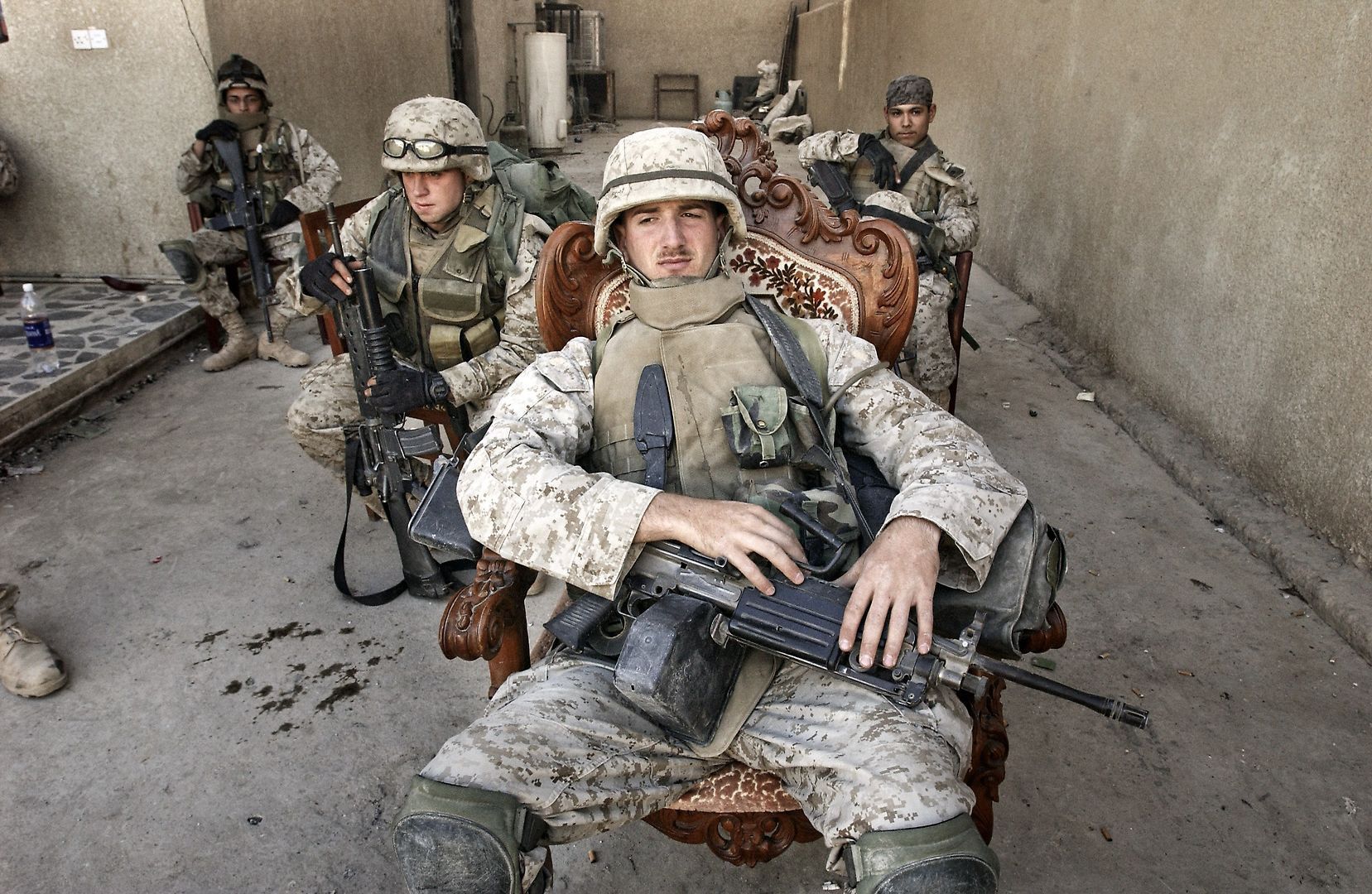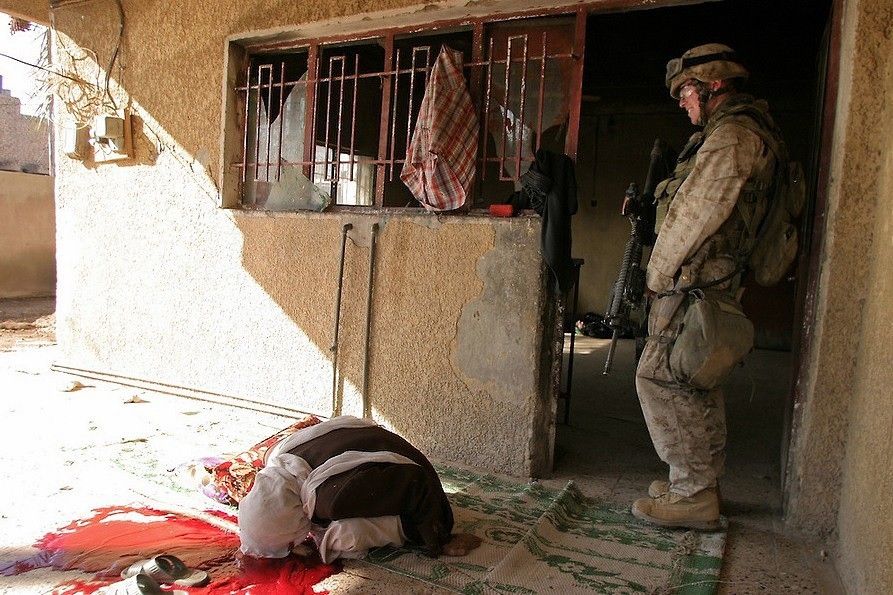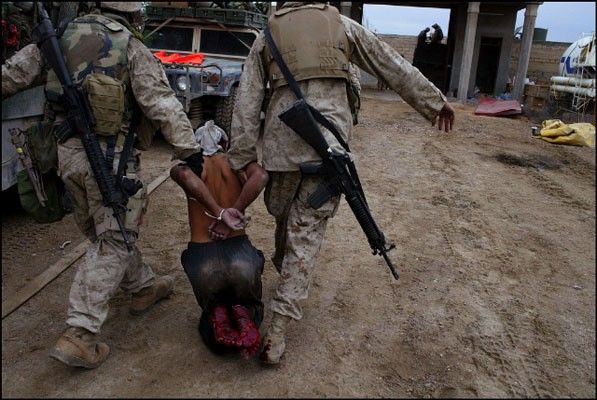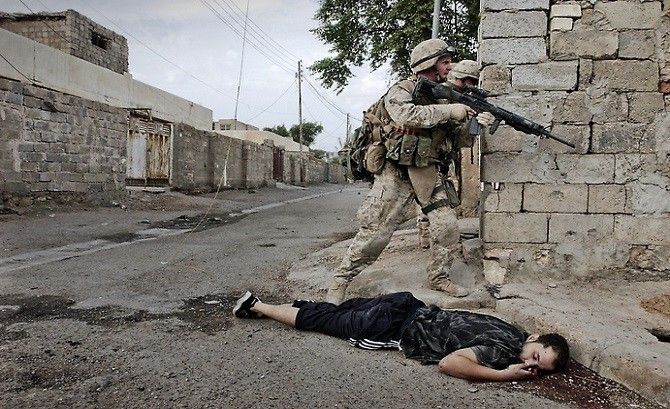The US-led war on the ‘Islamic State’ (ISIS/ISIL/IS) has brought the US back into Fallujah. Once again, the stated objective is to root out terrorists — but as with operations in Fallujah during the 2003 Iraq War, it is overwhelmingly civilians who are being killed.
Two weeks ago, the Pentagon announced that US airstrikes had been conducted near Fallujah in coordination with the Iraqi government against ISIS targets. “Four airstrikes struck land features denying ISIL a tactical advantage and destroyed two ISIL buildings, an ISIL VBIED, two ISIL heavy machine guns and an ISIL obstruction,” declared a Department of Defense (DoD) press release.
What the press release didn’t say is that the US-Iraqi targets included civilian structures, and resulted in a civilian massacre.
In this exclusive analysis for INSURGE, Iraq War veteran Ross Caputi — a former US Marine who served from 2004 to 2006 and participated in the second siege of Fallujah in November 2004 — shows how such double-speak is integral to US efforts to control how both soldiers and civilians perceive military operations.
The latest campaign in Fallujah, Caputi reveals, represents a continuation of these little-understood practices: the institutionalized contempt for civilian life in war zones, and the deliberate use of propaganda to conceal this contempt from public consciousness.
Nafeez Ahmed
On 13th August 2015, the Iraqi government bombed the Fallujah Maternity and Neonatal Hospital, killing 31 people, including 23 women and children.
This incident was widely reported in the Western media; though the coverage was perhaps cursory and even dismissive by labeling it an “IS-held” hospital. Nevertheless, information about this atrocity was available to the Western world, as is information about the many similar atrocities committed by the Iraqi government since the start of their war against the Sunni uprising and the Islamic State in December 2013.
This was in fact the 40th time that the Iraqi government has bombed a hospital in Fallujah, and in Fallujah alone over 4,000 civilians have been killed and 5,200 wounded in the last 20 months of government attack.
The United States has also been complicit in these killings; first by shipping weapons to the Iraqi government to facilitate their internal repression of Sunnis, and then by reinitiating a campaign of airstrikes in the Sunni majority provinces of Iraq in August 2014.
According to Airwars, a nonprofit group monitoring US-led coalition airstrikes against the Islamic State, “publicly-available evidence” alone shows that civilian casualties in Iraq and Syria from these airstrikes are significantly higher than what the US and its partners have claimed.
Though certainly not a trending topic, information on these killings is readily available to those who look for it. Yet despite easy access to these reports, the public’s reaction has never surpassed bland disapproval.
It is easy to chastise the American public for their indifference. But there is reason to believe that the American public doesn’t fully understand why Iraqis are dying in the staggering numbers that they are, who to blame for them, or what they could do to stop the bloodshed.
None of this is accidental. The public’s reaction to civilian casualties has been carefully crafted by the best thinkers in “strategic communications” — or in common parlance, “propaganda” — within the US military and government.
The invasion and occupation of Iraq occurred at a time when the US military’s strategic communications doctrine was just beginning to incorporate the presence of the media on the battlefield into their operational strategy. Managing public perceptions of the US military’s conduct in Iraq through Information Operations, or IO, became as much a part of their day-to-day affairs as was their use of airstrikes and infantry.
From the US-led invasion of Iraq in March of 2003 onward, reports of civilian deaths were frequent in the American media. However, several strategies were used to guide the public’s reaction to these deaths from outrage to perplexity.
Reports of civilian deaths were often claimed to be exaggerated by the enemy or were framed as insurgent propaganda. The cause of civilian deaths was obscured by tropes like “random violence” or “sectarianism.” And blame was often shifted to armed groups by accusing them of using “human shields.”
This is not to say that the US military was the only party responsible for civilian deaths in Iraq — just that it had a developed and resourceful strategy for communicating these deaths to the public in a way that would not elicit a public reaction.
The secret war to control what you think
To understand how this information campaign nurtured a disengaged public reaction to an occupation characterized by dirty war tactics and daily atrocities, it is important to understand something about the history and culture of the American propaganda apparatus.
The conduct of the US military’s information campaign in Iraq was influenced by doctrinal practices and prevailing attitudes within the military, State Department, and the Department of Defense towards propaganda and free media. This institutional culture evolved over the course of several decades of warfare and technological advances.
Information Operations’ oldest ancestor is a series of post-World War II initiatives to formalize and doctrinize the “psychological instrument” of warfare and statecraft, which became known as Psychological Operations, or PSYOP.
Information Operations wasn’t introduced as a military doctrine until the early 1980’s to counter the Soviet Union’s use of electronic warfare. At that point, “Information Operations” became an umbrella term for a number of military activities, including electronic warfare, computer network operations, propaganda, and PSYOP.
The principle difference between PSYOP and IO is that PSYOP is supposed to be directed at foreign audiences, including the enemy, and it may include “black” propaganda (deception). While IO is concerned with propaganda directed at domestic audiences through public affairs (PA) and public diplomacy (PD) platforms, IO practitioners claim their messages are always “truthful” and benevolent.
By the mid 90’s IO expanded its focus from “state-sponsored hackers” to a “full-spectrum” doctrine that sought to utilize every conceivable advantage offered by the militarized use of information. IO was incorporated into an extremely violent and highly technological military doctrine known as “maneuver war,” whose aim is to “overwhelm the enemy as rapidly as possible.” This later became known as shock and awe.
Information Operations become so important to military doctrine that the traditional notion of a battlefield was reconceptualized as a battlespace that reaches into the “hearts and minds” of citizens living in war zones and on the home front alike.

The goal of Information Operations is, straightforwardly, hegemony — to influence the enemy’s decisions and to shape global attitudes and beliefs so that American power will be embraced rather than contested.
Military historian Stephen Badsey notes that IO practice became more aggressive when a doctrinal publication in 1998 “emphasized the need for ‘offensive’ information operations directed towards shaping and misleading enemy perceptions.”
This further aggravated an ongoing debate within the US military and government over the proper relationship between PSYOP and public affairs.
Since the US’ propaganda apparatus is a cross-government activity, different military units conducting IO have to communicate with various government agencies to coordinate a consistent messaging strategy. Traditionally, there was a doctrinal “firewall” between PSYOPs and public affairs to ensure that black propaganda directed at foreign audiences did not make its way back to domestic audiences.
However, with a new globally connected internet and news media, “offensive” PSYOP can now easily reach domestic audiences. This has even provided a legal loophole through which domestic audiences can be indirectly targeted with PSYOP.
Emma Louise Briant, author of Propaganda and counter-terrorism (2015), notes that:
“Placing false stories in the media is referred to by the agencies [conducting IO in the US or UK] as ‘playback’, ‘spillover’ or ‘feed back’, especially where the intention is that it will make its way back home.”
Donald Rumsfeld had long been an advocate of using offensive IO. During his time as Secretary of Defense he made several organizational changes to increase the role of propaganda in US diplomacy and military operations.
He created the Office of Strategic Influence in 2001 to further this goal, but it was disbanded in 2002 after being exposed for planting ‘black’ and ‘grey’ propaganda in the global media. He also distributed a now declassified 74-page directive, “Information Operations Roadmap,” within the US government, which was intended to facilitate coordination between IO and public affairs.
The human consequences of this information campaign are most visible in Fallujah, and not just because they reverberate to this very day in our mini-war against the Islamic State. The US-led sieges of Fallujah in 2004 played a significant role in the evolution of IO doctrine and practice.
Truth-telling loses wars
It is widely believed within the US military that the US lost the First Siege of Fallujah due to its failure to control the “informational realm.” In other words, US leaders believed that their failure to either silence Al Jazeera’s reports of civilian casualties or provide a credible alternative perspective to international audiences led to unjustified public criticism and political pressure that forced them to end the operation.
Lieutenant General Thomas F. Metz, who led the 1st Marine Expeditionary Force’s information campaign in Iraq in 2004, regards the First Siege of Fallujah as “a cautionary tale for anyone who would downplay the significance of information in modern warfare” compared to the second more “successful” siege on the city, which he argues is a case study in the successful use of “aggressive information operations.”
The US’ defeat during First Siege of Fallujah advanced the issue of the IO-PA firewall from being a doctrinal debate to a matter of necessity. The possibility of the US being ejected out of a country that they claimed to be liberating had suddenly become real, and many within the US military and government came to believe that they urgently needed to make changes to the way they conducted IO.
Stephen Badsey notes that by the time of the second siege, “any distinctions between information operations and public affairs had largely vanished from US senior officers’ thinking and planning.”
Many argue that information warfare is more ethical than traditional forms of warfare that rely solely on killing. However, the institutional culture within the American propaganda apparatus shaped the ethical conduct of the information campaign against Fallujah in important ways.
This campaign was characterized by: a willingness to allow misinformation to reach American audiences, an antipathy for free media, a reflexive reliance on aggression to accomplish missions, and an attitude of extreme relativism towards truth.
Manufacturing Zarqawi
The US-led Coalition in Iraq used Information Operations in three notable ways to prepare for the Second Siege of Fallujah:
1) A US PSYOP disseminated misinformation about Abu Musab al Zarqawi, alleging him to be the leader of al-Qaeda in Iraqi and claiming that he chose the city of Fallujah as his base, from which he was recruiting his army and launching terrorist attacks all across Iraq. Zarqawi functioned in the Coalition’s rhetoric as an unequivocal ‘bad guy’, a threat to Americans and Fallujans alike, whose presence justified US military action in Fallujah.
2) The Coalition utilized several strategies for denying, dismissing, for shifting the blame for civilian deaths in Fallujah.
3) The Coalition suppressed or countered information that contradicted their stated goals and justifications for their actions. The use of embedded journalists to control the perspective from which international audiences perceived the operation — a perspective equal to the US military’s — was an essential component of their information campaign.
This information campaign unfolded gradually, first with a change in rhetoric that shifted their framing of the enemy from “old regime elements” to focusing on Zarqawi and al-Qaeda.
Abu Musab al Zarqawi was born Abu Hilalah Ahmad Fadil al-Nazal al-Khalayleh in Zarqa, Jordan. When Colin Powell addressed the UN Security Council in 2003 in an attempt to gain support for the invasion of Iraq, he claimed that Zarqawi was commanding an al-Qaeda affiliated cell in northeastern Iraq and had been offered a safe haven there by the regime of Saddam Hussein.
At that point Zarqawi had been a Mujahideen fighter for over ten years. He went to Afghanistan in the late 80’s and was rumored to have had ties with Osama bin Laden. After the invasion of Iraq, there was little mention of Zarqawi in the media for almost a year, until February 9th 2004 when a “selective leak” was made by the US military to an American journalist.
By mid-May of 2004, during the First Siege of Fallujah, allegations began to surface in the media about Zarqawi using Fallujah as a base for his military operations.
Rahul Mahajan, an American academic and blogger who was in Fallujah bearing witness during the first siege, noted the suspicious timing for Zarqawi’s name to reemerge in the media “at a time of maximal Shia-Sunni unity.”
It was rumored that Zarqawi bore an intense hatred for Shia Muslims and hoped to provoke a Sunni-Shia civil war in Iraq. Then a video entitled “Abu Musa’b al-Zarqawi slaughters an American” was released showing the decapitation of Nicholas Berg, an American contractor in Iraq, by masked Mujahideen, one of whom was assumed to be Zarqawi, and many Coalition intelligence analysts believed that the video was probably filmed in the Jolan neighborhood of Fallujah.
The rumors then developed to connect Zarqawi with Sheikh Abdallah al-Janabi and other local mujahideen leaders in Fallujah, like Omar Hadid. There was no evidence ever presented that Zarqawi ever even set foot in Fallujah, yet the media repeated these rumors profusely.
These speculations soon developed into conventional wisdom, and before long it was taken for granted by the Coalition that Zarqawi was indeed in Fallujah using the city as a base from which his organization, Tawhid al-Jihad — purportedly al-Qaeda’s wing in Iraq — was launching attacks all across the country. This became a widespread belief among US soldiers, from the lowest ranks to the highest levels of the chain-of-command.
However, in 2006 it was revealed that the US military had been conducting a PSYOP that intentionally exaggerated the role of Zarqawi in Iraq, and included making a “selective leak” about Zarqawi to New York Times journalist Dexter Filkins.
Fallujans always denied that Zarqawi was in their city. Yet only a handful of journalists ever questioned his role in Fallujah.
Nir Rosen reported that by late July “the leadership in Falluja met with foreign fighters in their city and expelled about twenty-five of them, including Syrians, Jordanians, and Saudis.” In fact “[s]everal resistance groups . . . issued a joint declaration calling for the blood of Abu Musab al-Zarqawi to be spilled. Their declaration also declared their friendship with Iraqi Shias and called for cooperation with the new Iraqi government led by Prime Minister Ayad Alawi.”
These reports suggest that the insurgency in Fallujah was not dominated by al-Qaeda; rather, local armed groups were in control and had the capability to eject foreign fighters like Zarqawi, when the latter placed their own military, political, and religious goals above Iraqi liberation.
Furthermore, Rosen documented a coalition bombing campaign that began on July 19th and claimed to target Abu Musab Al Zarqawi and his terror network in Fallujah, but ended up killing “scores of civilians.”

Hiding Fallujah’s dead
It was Lieutenant-General Sattler, Commanding General of the 1st Marine Expeditionary Force in Iraq in 2004, who issued final approval for all preselected individuals or houses before they were targeted by coalition airstrikes.
Sattler describes the tit-for-tat correspondence between airstrikes and propaganda as “a standard thing” in which after each strike:
“[a] press release went out from us, telling what we did, why we did it, [that] the individual was a thug, a two-bit criminal who has killed ‘X’ number of Iraqi civilians . . . So every time we struck, we told ‘em who [we] went after, who we thought we killed — i.e., a member of the Zarqawi network . . . ”
And yet after each strike, groups from within Fallujah claimed that civilians had been killed, “[a]nd then [Sattler and his team] would try to rebut that.”
Brigadier General Mark Kimmitt, then Deputy Director of Operations and Chief Military Spokesman in Iraq, claimed that the Zarqawi PSYOP was their “most successful information campaign to date” because it successfully drove a wedge between the insurgency and the Iraqi population.
The leaked briefing on the Zarqawi PSYOP asserts that:
“Through aggressive Strategic Communications, Abu Musab al-Zarqawi now represents: Terrorism in Iraq/Foreign Fighters in Iraq/Suffering of Iraqi People (Infrastructure Attacks)/Denial of Iraqi Aspirations.”
In reality, what this PSYOP achieved was the fomenting of sectarian attitudes within Iraq, by highlighting Zarqawi’s hatred of Shi’a Muslims and making him out to be a central figure of the Sunni insurgency. Future American policy and operations were then built on the misinformation disseminated by their own PSYOP, with disastrous consequences.
Keeping the peace
Another goal of the information campaign was to “put an Iraqi face” on the operation to retake Fallujah from insurgent control.
The new Prime Minister of Iraq, Iyad Allawi — a native of Baghdad who lived in exile for almost 30 years and was on the CIA’s payroll for most of the 90’s — played an instrumental role in facilitating the operation by aborting the peace negotiations, which began in mid-October.
The peace negotiations were led by Sheikh Khaled Hamoud al-Jumaili from Fallujah as their chief negotiator. For a brief period the negotiations were suspended by the Mujahideen Council because of the Coalition’s “continuous bombing in Fallujah.” However, when the negotiations resumed, many viewed their progress as hopeful.
The Washington Post reported:
“Local insurgent leaders voted overwhelmingly to accept broad conditions set by the Iraqi government, including demands that they eject foreign fighters from the city, turn over all heavy weapons, dismantle illegal checkpoints and allow the Iraqi National Guard to enter the city. In turn, the insurgents set their own conditions, which included a halt to US attacks on the city and acknowledgment by the military that women and children have been among the casualties in US strikes.”
Some former Coalition Provisional Authority (CPA) officials saw the peace negotiations as “a potential breakthrough that could avert not only an assault on Fallujah but also a violent aftermath, when insurgents might take the fight elsewhere.”
But Allawi demanded that the leadership in Fallujah turn Zarqawi over to the Coalition. It was a demand that Fallujans could never meet, an impossible condition on peace.
If you resent civilian casualties, you’re a terrorist
The American bombing campaign on Fallujah intensified through September and October until the beginning of the ground siege in November, and the American leaders insisted all the way that “[e]very bomb . . . we dropped has been a precision munition,” and that civilian casualties were “almost zero.”
In the coldly abstract language of Information Operations, civilian casualties were regarded merely as “IO challenges.” As Lieutenant-General Metz explains, IO challenges were things that “we could anticipate and for which we could plan.”

For example, Metz claims that they “took control of the [Fallujah] hospital the evening before the main attack on Fallujah, removing it from the enemy’s IO platform.”
The US military had long assumed the doctors at the Fallujah hospital to be a “terrorist-supportive staff,” and the hospital itself to be “little more than a nest of insurgent propagandists” because:
“That April they had used the facility to issue claims of non-existent civilian casualties.”
Embedded spin-doctors
Further preparations for IO challenges included the coalition’s decree that only embedded journalists would be allowed inside Fallujah during the second siege.
The “media commission” in Iraq, which was established by order 65 of Paul Bremer’s 100 Orders, sent out a warning to all journalists in Iraq that they should “stick to the government line on the U.S.-led offensive in Fallujah or face legal action.”
Journalists who tried to enter Fallujah without being embedded with Coalition Forces were detained. This time around, 91 journalists were embedded with Coalition units inside Fallujah who could “[offer] a rebuttal” to the “Arab media,” whereas in the first siege there was only one.
The objective of this approach was to show American audiences what the Coalition believed to be the “ground truth” — that is, the operation as it was seen through the eyes of the US military.
Encouraging civilians to flee Fallujah “amid general threats of an imminent US attack” was another way in which Coalition forces anticipated “IO challenges.”
The Coalition dropped leaflets to warn civilians of the coming assault, a PSYOP that Lieutenant General Metz describes as “very successful” because “almost 90% of the population departed Fallujah.”
Also, the electricity and water supply to the city were cut “to induce the few remaining civilians to leave.”
This provided a practical solution to the problem of crossing the “IO Threshold,” which General Metz describes as simply “the boundary below which the media is not interested and above which they are.”
In other words, the IO Threshold was not about the level of violence employed, but about limiting the extent to which it was reported in the media to avoid an “adverse political and public reaction” so that “US shaping operations and later attacks could be conducted with impunity.”

Consequences
Not only did the Zarqawi PSYOP create one of the most destructive myths about the insurgency in Iraq, one that contributed to sectarian violence and justified years of continued foreign occupation, but also Zarqawi has survived as an emblematic figure in the American collective memory of the occupation.
Zarqawi is cast as the representative ‘bad guy’ who symbolizes the presumed moral divide between Us and Them, and as the physical embodiment of the insurgency, characterized through such symbolism as a terrorist movement driven by religious fanaticism, rather than as a national liberation army.
Zarqawi continues to be portrayed in film and literature about the War on Terror, such as in American Sniper (2014), as the Iraq’s chief terrorist leading the insurgency from Fallujah.
And much of our strategy today in our mini-war against the Islamic State is based on the assumption that there is a straight line of continuity from Zarqawi’s terror network to ISIS. This assumption obscures the role of the Iraqi government’s internal repression of Sunnis, with US and British assistance, as the main causal factor in the emergence of the Islamic State, and instead places the onus of explanation on Islamic fundamentalism.
Moreover, Information Operations were the American public’s primary source of knowledge about the US-led invasion and occupation of Iraq.
Knowing this, we have to conclude that American indifference to civilian casualties is not arbitrary nor is it merely borne out of laziness or selfishness. It has a history and a psychology.
Our emotive response to civilian deaths in our foreign wars has been cultivated over America’s long history of war-making, with ever increasing sophistication.
An investigation into the psychological effects of information warfare naturally leads us to what John Tirman has called an “epistemology of war.” In his book The Deaths of Others (2012) he defines this “system of knowledge” as “an architecture of indifference” at least partly brought about by the one-dimensional ways in which we come to know about the victims of our wars.
And so it is crucial that we re-examine what we think we know about the US-led occupation of Iraq.
This is more than history, however. The bloodbath in Fallujah is ongoing.
At the time of writing, Iraqi and Iranian troops are massing around Fallujah for a much anticipated assault on the city, which they regard as being essential to their campaign to clear Anbar province of ISIS.
This assault will not take place on an empty battlefield, but in people’s neighborhoods, around their mosques and hospitals.
Fallujans are caught between a brutal sectarian government supported by the US and Iran on the one hand, and the Islamic State on the other: they will surely pay a heavy price.





